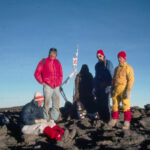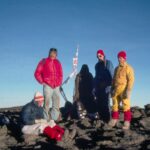Honestly, there´s few things in life which makes me as exhilarated, focused, positive, driven, hopeful and happy as planning a new Expedition. Nowadays, especially the part how you have to prepare physically. After 38 years in this trade, I am quite positive, that I have the mental aspect of what it takes under control. But the preparations for the physical part, once you enter the 60´s, are extremely important.
I have just finished a few long days of deep research into the subject of how to prepare for some of the highest mountains on earth and starting a period of alpinism and mountaineering. I have always felt in awe in the mountains, felt some kind of a call from the wild -well, the mountains- and have always had in mind, that before I stop kicking, spend a few years learning the trade of mountaineering and sending time among them. The time has come.
I did my first mountaineering training in New Zealand back in 1995, 5 days around the Mount Cook area and learned a lot, but never got to use it. My last one, was a rock climbing and safety course here in Skåne where I live, was with Mikael Blixt. Back in 2017, I think. Time to take a new one soon. I have noticed that I have to redo things all over again, and over again. And again. For them to stick. It is all training.
My big job right now, for which I have done this past week´s research, is how to figure this:
How do recover from the Icecap crossing, but still start training for the first high altitude job in April, followed by more technical climbing in September? How do I restructure a body which has spent 4 years preparing for the Greenland Icecap? I have realized I have to rebuild the body a bit, train very differently, strengthen all those areas which are weak when it comes to climbing. Like one issue on the Icecap was the small cracks I have in my knees, which at on and off, especially at night when it was time to pitch the tent, made it impossible almost to bend the knees. My research have shown that I need extensive work with my flexibility to deal with that and prepare for climbing.
And this is what I love! An Expedition in itself, as exciting, to train and prepare your body as good as you can. It is such a highlight in life!
Here´s the first phase to give you an idea.
Phase 1: Recovery and Base Building (December 2024 – January 2025)
• Goal: Recover from Greenland, rebuild flexibility and strength, and establish a solid aerobic base.
• Focus:
o Aerobic endurance: Steady hikes and runs at low to moderate intensity.
o Strength: Focus on controlled movements, eccentric exercises, and core stability.
o Flexibility: Daily mobility work and yoga to address stiffness.
Weekly Breakdown:
Day Activity
Monday Trail running (45–60 min, moderate pace).
Tuesday Strength training (lower body + core) + yoga.
Wednesday Weighted hike (2–3 hours, 10–15 kg pack).
Thursday Treadmill incline walk (60 min, 10–15% incline).
Friday Active recovery: Swimming or yoga.
Saturday Long hike (4–6 hours, light pack, 10 kg).
Sunday Strength training (upper body + core) + yoga.
In February I will increase my training.
It also feels like a fresh start in life. Something new and exciting. And reality is, and this is possibly of help to anyone trying to figure out how to survive our modern existence in our spoilt Western world, with the right attitude and training, most obstacles can be overcome.
The book Training For The New Alpinism was extremely helpful. That is also the joy of time, how fantastic we human beings are to adapt and find new ways to become better. For example, climbing Everest today is very different compared to John Hunt’s 1953 British Mount Everest Expedition, which successfully saw Edmund Hillary and Tenzing Norgay summit the mountain, relied heavily on the support of Sherpas and porters. The team included approximately 362 porters, who carried nearly 10.5 tons of supplies to support the climbers and the extensive expedition infrastructure! It took them weeks do do the succesful climb. Sure, everything was much harder and more difficult of course, but still, 2017, it took Kilian Jornet 26 hours (!) from advanced base camp and up. Without supplemental oxygen or fixed ropes.















